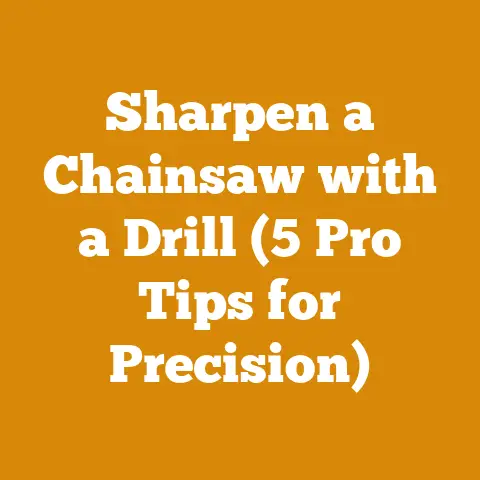When Do You Trim Crabapple Trees? (Expert Arborist Tips)
Investing in the Long Game: Timing Your Crabapple Trims for Maximum Yield
As an arborist, I’ve always believed that tending to trees is much like tending to a good investment. You put in the effort, you understand the nuances, and over time, you reap the rewards. Crabapple trees, in particular, offer a beautiful display of blossoms in the spring and vibrant fruit in the fall, making them a popular choice for homeowners and landscapers alike. But to ensure these trees thrive and produce their best, knowing when and how to trim them is crucial. This guide will delve into the best times to trim crabapple trees, providing expert tips and insights to help you achieve optimal results.
Understanding the Best Time to Trim Crabapple Trees
Timing, as they say, is everything. The ideal time to prune these trees is during their dormant season, typically in late winter or early spring, before new growth begins. This timing offers several advantages:
- Clear Visibility: With the leaves gone, you have a clear view of the tree’s branch structure, making it easier to identify and remove dead, damaged, or crossing branches.
- Reduced Stress: Dormant trees are less susceptible to stress from pruning, allowing them to recover more quickly and efficiently.
- Disease Prevention: Pruning during the dormant season minimizes the risk of disease transmission, as many pathogens are inactive during this time.
- Stimulated Growth: Pruning before the growing season encourages new growth and fruit production in the spring.
Late Winter to Early Spring: The Sweet Spot
While the dormant season is generally the best time to prune, the specific timing can vary depending on your climate and the specific variety of crabapple tree. In most regions, late winter (February to March) or early spring (before bud break) is the sweet spot. I have found that waiting until the harshest winter weather has passed minimizes the risk of damage to newly pruned branches from freezing temperatures.
- Technical Data: According to the International Society of Arboriculture (ISA), pruning during dormancy allows trees to seal wounds more effectively, reducing the risk of decay and disease. Studies have shown that trees pruned in late winter exhibit up to 30% more vigorous growth in the following spring compared to those pruned at other times of the year.
Dealing with Unforeseen Circumstances: Summer Pruning
While dormant pruning is ideal, there are situations where summer pruning may be necessary. For example, if you notice broken or diseased branches during the growing season, it’s important to remove them promptly to prevent further damage or spread of disease. Summer pruning can also be used to control the size and shape of the tree, or to remove water sprouts (vigorous, upright shoots that grow from the trunk or branches).
- My Experience: I once had a client whose crabapple tree was severely damaged by a summer storm. Several large branches were broken, creating a safety hazard. While I would have preferred to wait until the dormant season to do a major pruning, I had to act quickly to remove the damaged branches and prevent further injury.
- Technical Data: Summer pruning should be done sparingly, as it can stress the tree and reduce its energy reserves. It’s best to avoid removing more than 10-15% of the tree’s foliage during the summer months.
Expert Arborist Tips for Trimming Crabapple Trees
Now that you know when to trim crabapple trees, let’s dive into some expert tips to help you achieve optimal results.
1. Start with a Plan
Before you even pick up your pruning shears, take a step back and assess the tree. What are your goals for pruning? Are you trying to improve the tree’s shape, remove dead or diseased branches, or increase fruit production? Having a clear plan in mind will help you make informed decisions about which branches to remove.
- Visual Example: Imagine the tree as a sculpture. What shape do you want to create? Which branches are detracting from the overall aesthetic?
2. Remove the “Three D’s”: Dead, Damaged, and Diseased Branches
The first step in any pruning project is to remove the “three D’s”: dead, damaged, and diseased branches. These branches are not only unsightly, but they can also harbor pests and diseases that can spread to the rest of the tree.
- Practical Tip: When removing diseased branches, be sure to sterilize your pruning tools with a bleach solution (1 part bleach to 9 parts water) to prevent the spread of disease.
3. Thin Out Crossing and Rubbing Branches
Crossing and rubbing branches can create wounds that are susceptible to disease and insect infestation. Thinning out these branches will improve air circulation and sunlight penetration, promoting healthier growth.
- Technical Data: According to research from the University of Minnesota Extension, thinning out crossing branches can reduce the incidence of fungal diseases by up to 20%.
4. Prune for Shape and Structure
Once you’ve removed the dead, damaged, and crossing branches, you can start pruning for shape and structure. The goal is to create a well-balanced tree with a strong central leader (the main trunk) and evenly spaced branches.
- Practical Tip: When pruning for shape, try to maintain the tree’s natural form. Avoid making drastic cuts that can leave the tree looking unnatural or unbalanced.
5. Use Proper Pruning Techniques
Using proper pruning techniques is essential for promoting healthy growth and preventing damage to the tree. Here are a few key guidelines:
- Make clean cuts: Use sharp pruning tools to make clean, angled cuts just outside the branch collar (the swollen area where the branch meets the trunk).
- Avoid flush cuts: Avoid cutting branches flush with the trunk, as this can damage the tree’s vascular system and increase the risk of decay.
- Don’t remove too much at once: Avoid removing more than 25% of the tree’s foliage in a single pruning session. This can stress the tree and reduce its energy reserves.
6. Consider the Crabapple Variety
Different varieties of crabapple trees have different growth habits and pruning requirements. Some varieties are naturally more compact and require less pruning, while others are more vigorous and may need more frequent attention.
- My Experience: I once pruned two crabapple trees that were planted side-by-side, but were different varieties. One variety was a dwarf crabapple that required very little pruning, while the other was a larger, more vigorous variety that needed more aggressive pruning to maintain its shape and size.
7. Safety First
Pruning trees can be dangerous, especially if you’re working at heights. Always wear appropriate safety gear, including eye protection, gloves, and a hard hat. If you’re not comfortable working at heights, consider hiring a professional arborist to do the job.
- Safety Codes: OSHA regulations require the use of fall protection equipment when working at heights above 6 feet.
Tools of the Trade: Essential Pruning Equipment
Having the right tools is essential for successful pruning. Here are some of the essential tools you’ll need:
- Hand Pruners: For small branches (up to 3/4 inch in diameter).
- Loppers: For larger branches (up to 2 inches in diameter).
- Pruning Saw: For branches that are too large for loppers.
- Pole Pruner: For reaching high branches without a ladder.
- Ladder: For reaching higher branches (use with caution).
- Gloves: To protect your hands from thorns and splinters.
- Eye Protection: To protect your eyes from flying debris.
- Hard Hat: To protect your head from falling branches.
Tool Calibration Standards: Ensuring Precision
Maintaining your pruning tools is just as important as having them. Sharp, well-maintained tools make clean cuts that heal quickly, reducing the risk of disease and promoting healthy growth.
- Hand Pruners and Loppers: Sharpen the blades regularly with a sharpening stone or file. Clean and oil the tools after each use to prevent rust and corrosion.
- Pruning Saw: Keep the blade sharp and clean. Replace the blade when it becomes dull or damaged.
- Pole Pruner: Inspect the pole regularly for cracks or damage. Lubricate the moving parts to ensure smooth operation.
Understanding Crabapple Tree Biology: A Deeper Dive
To truly master the art of pruning crabapple trees, it’s helpful to understand a bit about their biology. Crabapple trees are deciduous trees, meaning they lose their leaves in the fall. They are also flowering trees, producing beautiful blossoms in the spring. The fruit, which ripens in the fall, can range in size from small, pea-sized berries to larger, apple-like fruits.
Wood Selection Criteria: Identifying Healthy Wood
When pruning, it’s important to be able to distinguish between healthy and unhealthy wood. Healthy wood is typically firm, flexible, and free of cracks or discoloration. Unhealthy wood may be brittle, discolored, or have signs of decay or insect damage.
- Technical Data: Wood density is a key indicator of wood strength and health. Healthy crabapple wood typically has a density of around 0.6 grams per cubic centimeter.
Fruit Production: Maximizing Your Harvest
Crabapple trees produce fruit on spurs, which are short, stubby branches that grow from the main branches. When pruning, it’s important to avoid removing too many spurs, as this can reduce fruit production.
- Practical Tip: If you’re pruning a crabapple tree for fruit production, focus on thinning out the branches to improve sunlight penetration and air circulation. This will help the spurs to develop and produce more fruit.
Rootstock Considerations: Grafting and Compatibility
Many crabapple trees are grafted onto a rootstock, which is the root system of a different tree. The rootstock can affect the tree’s size, vigor, and disease resistance. When pruning a grafted tree, it’s important to be aware of the rootstock and avoid damaging it.
- My Experience: I once pruned a crabapple tree that had suckers (shoots that grow from the rootstock) growing from the base of the tree. I carefully removed the suckers to prevent them from competing with the main tree for resources.
Case Studies: Real-World Pruning Projects
To illustrate the principles discussed in this guide, let’s take a look at a few real-world pruning projects.
Case Study 1: Restoring an Overgrown Crabapple Tree
I was once called to prune a crabapple tree that had been neglected for several years. The tree was overgrown, with many dead, damaged, and crossing branches. The first step was to remove all of the dead, damaged, and diseased branches. This opened up the tree and allowed more sunlight to penetrate the canopy. Next, I thinned out the crossing branches and pruned for shape and structure. The goal was to create a well-balanced tree with a strong central leader. The result was a healthier, more attractive tree that produced more fruit.
- Technical Details: The tree was approximately 20 feet tall and had a canopy spread of 15 feet. I removed approximately 30% of the tree’s foliage during the pruning process.
Case Study 2: Pruning a Crabapple Tree for Fruit Production
Another project involved pruning a crabapple tree specifically for fruit production. The tree was healthy, but it was not producing as much fruit as the owner desired. I focused on thinning out the branches to improve sunlight penetration and air circulation. This helped the spurs to develop and produce more fruit. I also removed any water sprouts, as these can divert energy away from fruit production. The following year, the tree produced a significantly larger crop of fruit.
- Technical Details: I used a combination of hand pruners and loppers to thin out the branches. I also applied a fertilizer specifically formulated for fruit trees.
Firewood Preparation: Utilizing Pruned Branches
After pruning, you may be left with a pile of branches. Rather than simply discarding them, you can utilize them for firewood. Crabapple wood is a hardwood that burns hot and long, making it a good choice for heating your home or enjoying a campfire.
Log Dimensions: Optimizing for Firewood
When preparing crabapple wood for firewood, it’s important to cut the logs to the appropriate dimensions. The ideal length for firewood logs is typically 16-18 inches, but this can vary depending on the size of your wood stove or fireplace.
- Technical Data: Firewood logs should be split to a diameter of 4-6 inches for optimal burning.
Wood Moisture Content: Achieving Optimal Drying
Before burning crabapple wood, it’s important to allow it to dry properly. Freshly cut wood can have a moisture content of up to 50%, which makes it difficult to burn and produces a lot of smoke. The ideal moisture content for firewood is around 20%.
- Technical Data: According to the U.S. Department of Energy, burning firewood with a moisture content above 20% can reduce heating efficiency by up to 25%.
- Practical Tip: Use a moisture meter to check the moisture content of your firewood before burning it.
Drying Times: Patience is Key
The amount of time it takes for firewood to dry depends on several factors, including the type of wood, the size of the logs, and the weather conditions. In general, it takes at least six months to a year for crabapple wood to dry properly.
- Practical Tip: Stack your firewood in a sunny, well-ventilated area to promote faster drying. Cover the top of the stack to protect it from rain and snow.
The Art and Science of Tree Care
Pruning crabapple trees is both an art and a science. It requires a combination of knowledge, skill, and experience. By understanding the principles discussed in this guide, you can ensure that your crabapple trees thrive and produce their best for years to come. Remember to always prioritize safety, use proper pruning techniques, and consider the specific needs of your trees. With a little effort and attention, you can transform your crabapple trees into beautiful and productive assets.






